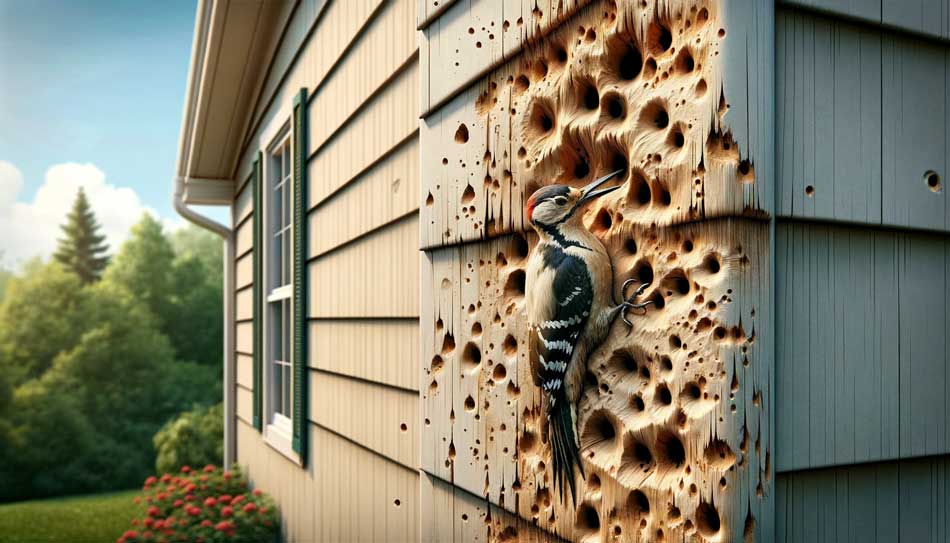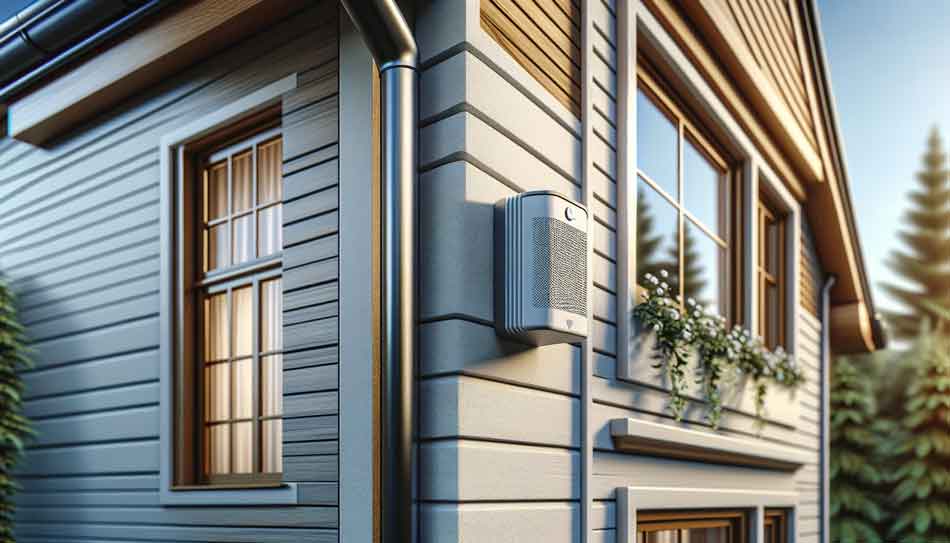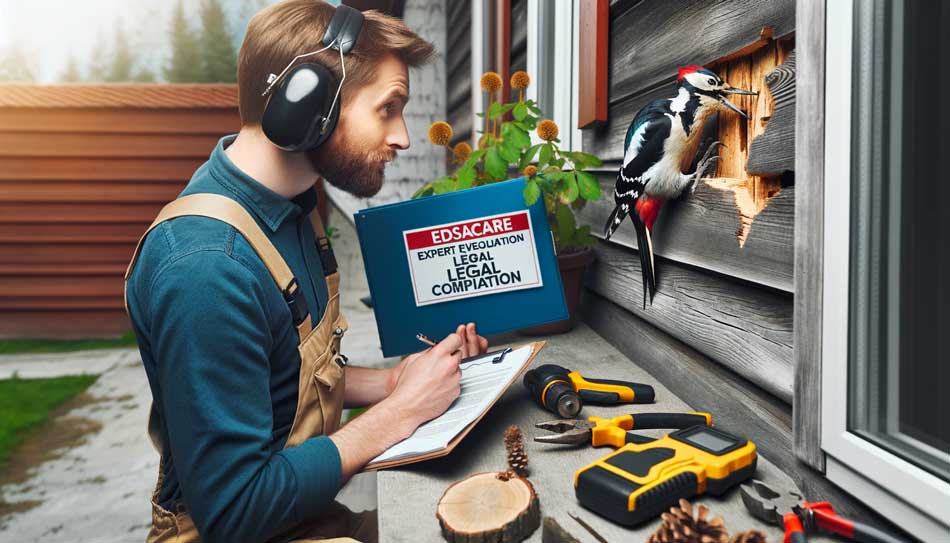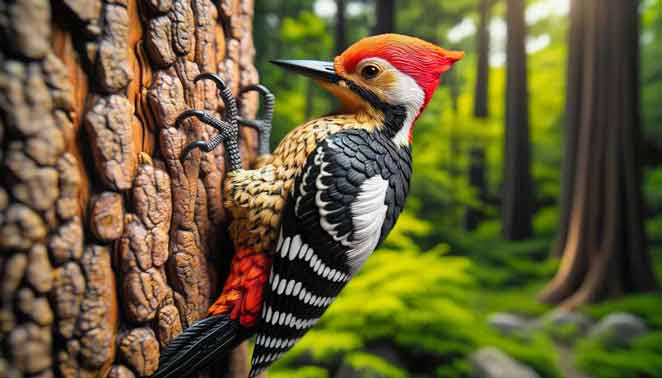Discovering the rhythmic tap of a woodpecker on your property can initially be a quaint nod to nature’s presence. However, when these pecks turn into a relentless endeavor, it’s essential to learn how to get rid of woodpeckers safely and effectively. This task, while crucial, requires a gentle approach, respecting both the bird’s well-being and the integrity of your home.
Woodpeckers, with their striking plumage and distinctive behavior, are fascinating creatures. But their drumming, meant for attracting mates or searching for insects, can cause significant damage to wooden structures. Therefore, finding humane and simple solutions is key to mitigating this issue.
In this guide, we’ll explore various strategies to protect your property from these persistent birds without causing them harm. Whether through deterrents, habitat modifications, or professional advice, our goal is to maintain harmony between human and avian cohabitants.
Understanding Woodpeckers and Their Behavior
Why Woodpeckers Peck: The Science Behind the Behavior
Woodpeckers peck for a myriad of reasons, each echoing the bird’s natural instincts and necessities. This behavior, primarily a quest for insects hiding beneath bark, also plays a crucial role in their mating rituals and territory claims. Imagine the woodpecker’s beak as a tool, one that taps into the wooden canvases of our homes in search of sustenance or to carve out a nesting site. It’s a fascinating, albeit sometimes problematic, display of nature at work.

The Impact of Woodpeckers on Your Home
The charm of a woodpecker’s visit fades quickly when the exterior of your home suffers. From minor aesthetic damage to significant structural harm, these birds can unintentionally become quite the nuisance. Their drumming, though a natural call to the wild, echoes through the wooden beams and siding, leaving behind a reminder of their presence in the form of holes and marks. It’s a delicate balance, respecting these creatures while protecting our homes from their persistent pecking.

Moving through our guide, we’ll delve into non-harmful, effective strategies to discourage woodpeckers, aiming to preserve both our homes’ integrity and the birds’ safety. With a bit of knowledge and the right approach, coexistence is certainly within reach, ensuring that the tap-tap-tapping becomes a distant, albeit memorable, part of our living experience with nature.
Safe Methods: How to Get Rid of Woodpeckers
Visual Deterrents: A Non-Harmful Approach
The key to discouraging woodpeckers without causing them harm lies in leveraging their natural instincts. Visual deterrents, for instance, can be incredibly effective. Reflective objects like mirrors, old CDs, or even metallic streamers can create unpredictable movements and reflections when caught by the wind, unsettling the woodpeckers and encouraging them to seek a more peaceful territory.

Fake predators, such as owl or hawk decoys, can also play a significant role in making woodpeckers think twice before approaching your property. Positioning these decoys strategically around the areas most frequented by the birds can create an illusion of danger, tapping into their instinct to avoid predators.

Auditory Solutions: Scaring Woodpeckers Away with Sound
Another angle to consider is auditory deterrents. Noise machines that mimic the sounds of woodpecker predators or distress calls can be surprisingly effective. These devices can create an environment that feels unsafe to woodpeckers, encouraging them to move on without ever coming into harm.

How to get rid of woodpeckers with ultrasonic repellents, although they have mixed results, represent another sound-based strategy. These devices emit frequencies that are uncomfortable for woodpeckers and other wildlife, serving as a deterrent without the need for physical barriers or harmful substances.

Combining visual and auditory deterrents can provide a comprehensive solution to managing woodpecker activity around your home. It’s a humane approach that respects the natural behavior of these birds while protecting the sanctity of our living spaces. As we move forward, we’ll explore additional strategies to keep your property less appealing to woodpeckers, ensuring peace and preservation for both parties.
Habitat Modification: Making Your Home Less Appealing
Seal Off Entry Points
One of the most straightforward ways to deter woodpeckers from considering your home as their next nesting or feeding site is by eliminating access to potential entry points. Inspecting your home for holes or cracks and promptly sealing them not only prevents woodpeckers from moving in but also enhances your home’s overall insulation and security. Using wood filler or metal mesh can be particularly effective, ensuring that these birds cannot peck their way through to create a new home.
Food Source Management
Equally important is managing potential food sources that attract woodpeckers to your property. If your yard is a haven for insects, especially those that woodpeckers feast on, it might be time to address these populations. Consult with pest control professionals to treat infestations that might be drawing these birds closer. Additionally, rethinking your bird feeder strategy—perhaps by choosing seeds less attractive to woodpeckers or placing feeders away from the house—can also help divert their attention elsewhere.
When to Seek Professional Help
Assessing the Severity of the Problem
Despite our best efforts, sometimes the situation with how to get rid of woodpeckers can escalate, causing significant damage or stress. If you’ve implemented various strategies without success, it might be time to consult with a wildlife control expert. These professionals can offer targeted advice, humane removal solutions, and preventive measures tailored to your specific situation, ensuring that the solution is effective and respectful to the wildlife involved.
Legal Considerations and Wildlife Protection Laws
Before taking any action, it’s crucial to be aware of the local wildlife protection laws. Woodpeckers are protected under various regulations, making it illegal to harm or kill them without proper authorization. Professional wildlife services are knowledgeable about these legalities and can ensure that any actions taken are within the bounds of the law, safeguarding both you and the bird population.

Conclusion to How to Get Rid of Woodpeckers
Navigating the challenge of coexisting with woodpeckers requires patience, understanding, and a commitment to humane solutions. By employing a mix of deterrents, habitat modifications, and, when necessary, professional assistance, it’s possible to address woodpecker issues effectively. Remember, the goal is to discourage these fascinating birds from damaging our homes while respecting their place in the ecosystem. With the right approach, we can achieve a balance that benefits both humans and woodpeckers alike.









